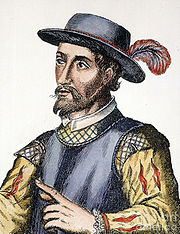Juan Ponce de León

(c. 1460 – July 1521) A Spanish conquistador. He was born in Santervás de Campos (Valladolid). As a young man he joined the war to conquer Granada, the last Moorish state on the Iberian peninsula. Ponce de León accompanied Christopher Columbus on his second voyage to the New World. He became the first Governor of Puerto Rico by appointment of the Spanish Crown. He is regarded as the first European known to have visited what is now the continental United States, as he set foot in Florida in 1513.
It is thought that Ponce first landed on the site where Cockburn Town is located, on Grand Turk in the Turks & Caicos Islands. Ponce de León settled in Hispaniola after arriving in the New World. He helped conquer the Tainos of the eastern part of Hispaniola, and was rewarded with the governorship of the Province of Higuey that was created there. While there he heard stories of the wealth of Boriken (now Puerto Rico), and he sought and received permission to go there. In 1508, Ponce de León founded the first settlement in Puerto Rico, Caparra (later relocated to San Juan).
The Fountain of Youth
The popular story that Ponce de León was searching for the Fountain of Youth when he discovered Florida is misconceived. He was seeking a spiritual rebirth with new glory, honor, and personal enrichment, not a biological rebirth through the waters of the Fountain of Youth. The Tainos had told the Spanish of a large, rich island to the north named Bimini, and Ponce de Leon was searching for gold, slaves and lands to claim and govern for Spain, all of which he hoped to find at Bimini and other islands. The story of Ponce de León searching for the Fountain of Youth seems to have surfaced in the 1560s in the Memoir of Hernando de Escalante Fontaneda, and was later included in the Historia general de los hechos de los Castellanos of Antonio de Herrera y Tordesillas. The statue was made in New York in 1882 using the bronze from English cannons seized after the English attacked San Juan in 1792.
First voyage and discovery of Florida
Ponce de León equipped three ships at his own expense, and set out on his voyage of discovery and conquest in 1513. On March 27, 1513, he sighted an island, but sailed on without landing. On April 2 he landed on the east coast of the newly "discovered" land at a point which is disputed, but was somewhere on the northeast coast of the present State of Florida. Ponce de León claimed "La Florida" for Spain. He named the land La Florida, meaning flowery, either because of the vegetation in bloom he saw there, or because he landed there during Pascua Florida, Spanish for Flowery Passover, meaning the Easter season. Pascua Florida Day, April 2, is a legal holiday in Florida.
Ponce de León then sailed south along the Florida coast, charting the rivers he found, passed around the Florida Keys, and up the west coast of Florida to Cape Romano. He sailed back south to Havana, and then up to Florida again, stopping at the Bay of Chequesta (Biscayne Bay) before returning to Puerto Rico.
Ponce de León may not have been the first European to reach Florida. He encountered at least one Native American in Florida in 1513 who could speak Spanish.
Last Voyage
In 1521 Ponce de León organized a colonizing expedition on two ships. It consisted of some 200 men, including priests, farmers and artisans, 50 horses and other domestic animals, and farming implements. The expedition landed on the southwest coast of Florida, somewhere in the vicinity of the Caloosahatchee River or Charlotte Harbor. The colonists were soon attacked by Calusas and Ponce de León was injured by a poisoned arrow. After this attack, he and colonists sailed to Havana, Cuba, where he died. His tomb is in the cathedral in Old San Juan.

No comments:
Post a Comment